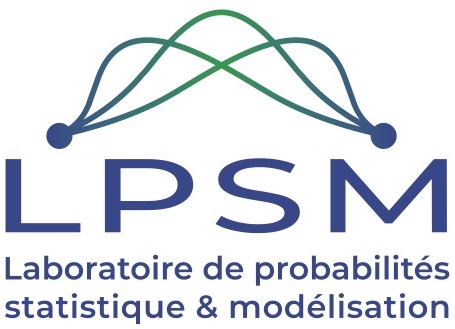3.4. Gradient stochastique#
Il s’agit ici de présenter l’algorithme du gradient stochastique et de prouver uniquement la convergence en norme \(\mathbf{L}^2\) dans un cadre fortement convexe.
3.4.1. Préliminaires déterministes#
Soit \(g:\mathbf{R}^d \to \mathbf{R}\) une fonction réelle de classe \(\mathcal{C}^1\) \(\alpha\)–fortement convexe sur \(\mathbf{R}^d\) c’est à dire telle qu’il existe \(\alpha > 0\)
où \(\nabla g: \mathbf{R}^d \to \mathbf{R}^d\) est le gradient de \(g\). Sous cette hypothèse (plus forte que la stricte convexité car \(\alpha > 0\)), il existe un unique minimum \(\theta^*\) de \(g\), i.e. \(\operatorname{argmin}(g) = \{\theta^*\}\), et le gradient s’annule en \(\theta^*\), \(\nabla g(\theta^*) = 0\). Cette hypothèse \(g\) \(\alpha\)–fortement convexe peut s’exprimer directement sur le gradient en remarquant
donc en sommant ces 2 inégalités et en utilisant \(\nabla g(\theta^*) = 0\) on obtient
Le problème initiale d’optimisation de la fonction \(\alpha\)–fortement convexe \(g\) se ramène à la recherche du zéro d’une fonction \(f:\mathbf{R}^d \to \mathbf{R}^d\) (qui est un gradient) vérifiant \(\{f = 0\} = \{\theta^*\}\) et
Un algorithme déterministe, appelé algorithme de Newton-Raphson, converge vers le zéro \(\theta^* \in \mathbf{R}^d\) et est défini par la suite
où \(J_f(\theta)\) est la matrice jacobienne de \(f\) (la Hessienne de la fonction \(g\) si \(f = \nabla g\)). Cette matrice jacobienne indique la pente optimale (se convaincre avec \(d = 1\) ou voir le cours d’optimisation) à suivre pour converger vers le zéro \(\theta^*\). Si la matrice jacobienne de \(f\) n’est pas connue on peut considérer une variante non-optimale
avec \((\gamma_n)_{n \ge 1}\) une suite de réels positifs qui tend vers 0 telle que \(\sum_n \gamma_n = +\infty\). Pour cet algorithme non-optimal à pas décroissant, on peut aussi prouver que \(\lim_n \theta_n = \theta^*\).
3.4.2. Cadre probabiliste#
Supposons maintenant que la fonction \(f\) a la représentation probabiliste suivante
où \(X\) est une variable aléatoire à valeurs dans \(\mathbf{R}^q\) et \(F:\mathbf{R}^d \times \mathbf{R}^q \to \mathbf{R}^d\) est une application mesurable. L’algorithme \eqref{eq:algo_newton} s’écrit alors
et pour le calcul de \(\mathbf{E} \big[ F(\theta_k, X) \big]\) on peut considérer un estimateur de Monte Carlo de la forme \(\frac{1}{n} \sum_{j=1}^n F(\theta_k, X_k^{(j)})\) où la suite doublement indicée \((X_k^{(j)})_{k \ge 1,j \ge 1}\) est i.i.d. de même loi que \(X\). L’algorithme du gradient stochastique s’écrit avec le choix particulier (et remarquable) \(n = 1\), c’est à dire qu’il s’écrit
où \((X_k)_{k \ge 1}\) est une suite i.i.d. de copies de \(X\). Voici un résultat de convergence.
Proposition 3.9
Soit \(\theta_0 \in \mathbf{R}^d\) fixé et \((\theta_k)_{k \ge 1}\) définie par la récurrence (3.15) où \(f(\theta) = \mathbf{E}\big[F(\theta, X) \big]\) vérifie
et \(\theta \mapsto F(\theta, X)\) est à croissance sous-linéaire en norme \(\mathbf{L}^2\) i.e.
Alors \(\lim_{n \to \infty} \|\theta_n - \theta^*\|_{_2} = 0\).
Proof. Par définition de l’algorithme (3.15) on a
et en posant \(D_{k+1} = \langle \theta_k - \theta^*, F(\theta_k, X_{k+1}) - f(\theta_k) \rangle\) on a
Par l’hypothèse sur \(f\) on obtient
La variable \(D_{k+1}\) est d’espérance nulle car \(X_{k+1}\) est indépendante de \(\theta_k\) et en préconditionnant par rapport à \(\theta_k\) on obtient
car \(\mathbf{E}\big[F(\theta_k, X_{k+1})|\theta_k\big] = f(\theta_k)\). Ainsi en prenant l’espérance de (3.16) on obtient
Par l’hypothèse (essentielle) de croissance sous-linéaire de \(\theta \mapsto F(\theta, X)\) en norme \(\mathbf{L}^2\) on a
On conclut par le lemme de Gronwall discret.
